Positively identified only recently, this Victorian collier sunk off the Sussex coast has not been much dived, says JOHN LIDDIARD, but beware possible poor vis. Illustration by MAX ELLIS
THIS MONTH’S WRECK is another that I first dived when it was an unknown. Skipper Dave Ronnan simply marked it as JR1 on Our-W’s plotter, and that is how I had the dive recorded in my logbook.
At one point the Stanhope was proposed and then eliminated because there were not enough boilers, but the wreck was then often referred to as “Not the Stanhope”.
The Stanhope was subsequently identified by Tunbridge Wells Sub-Aqua Club (TWSAC) in 2011 and featured as Wreck Tour 163 last June.
Other missing wrecks at one time considered were the Horst Martini and the Mid Surrey. Then, in March 2011, TWSAC diver Ian Davies traced the ship from the engine maker’s plate “John Dickinson No. 260 1882”, and identified it as the 994-ton steamship Newent, most likely lost in a collision with a Norwegian barque in 1909.
As usual, our tour begins with a shotline hooked across the wreck by the single boiler (1), which at the time provided the immediate evidence that this was definitely not the Stanhope. Either side of the boiler is coal-bunker space in a typical saddle configuration.
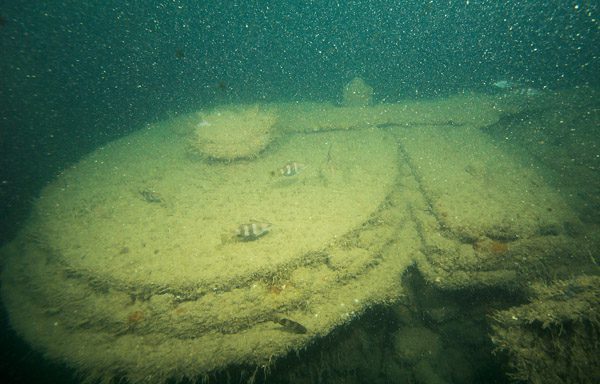
A thick steam pipe (2) from the aft end of the boiler leads to a fine example of a two-cylinder compound engine (3), standing high among debris that has fallen down to either side in the engine-room. An intact bulkhead separates the engine-room from the aft holds, now full of banked silt.
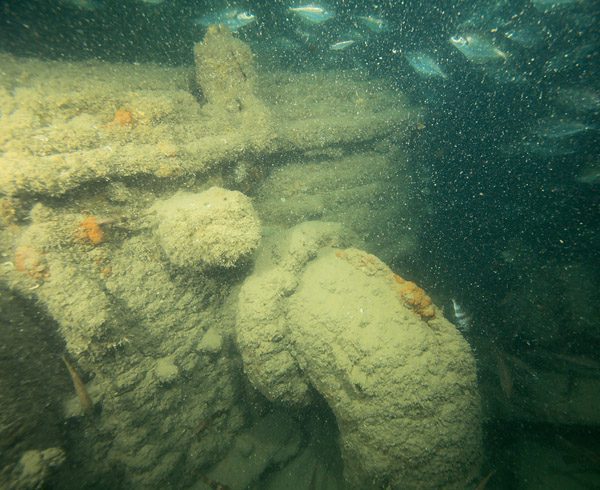
Following the starboard side of the deck aft, the depth is now 33m. A curved tube-section lying on the deck is one of the boat davits (4).
Halfway along the side of the hold is a small pair of bollards (5) and then a thinner steam pipe (6) leads across the deck between the aft holds to the mountings for a winch. The winch itself (7) has fallen into the aft hold.
Back on the starboard side of the deck is a reel of cable (8), then, halfway along the aft hold, another pair of small bollards (9).
Now at the stern (10), it is at once apparent that the quarterdeck was flush, with no raised poop deck. The sides of the deck and hull are slightly splayed out where they have decayed.
The steering was by a simple tiller-arm (11), at one time pulled by chains from the helm further forwards.
Dropping down the rudder-post, the rudder (12) stands partly clear of a scour in the silt with, at the time of my dive, a single blade of the propeller visible at 41m.
However, silt banks shift, especially in the strong tides of Beachy Head, and divers have subsequently reported that three blades of the propeller are showing.
Returning forward along the port side of the deck, the layout of deck fittings is now familiar, with a pair of small bollards by the midpoint of the hold (13), a cable reel between the holds (14) and another pair of bollards at the midpoint of the next hold (15).
By the aft end of the boiler, a rectangular plate (16) lies askew on the port side of the deck. It is the right size for a hatch cover, but there are no obvious openings from which it could have fallen.
Crossing the wreck forward of the boiler, tucked into the forward starboard corner of the stokehold is an upright water tank (17).
Our tour has crossed the wreck, because this is where I think it gets really interesting. The starboard side of the hull is stoved in, in the obvious V-shape of a sailing ship’s bow, though a little ragged.
Further evidence of the impact comes where the bulkhead has slightly folded and broken in the centre, as a consequence of the hull being pushed in from the starboard side.
At the bottom of the V-shaped rent and a little way into the hull is a pair of small anchors (18), which could easily have come from the bow of the barque.

Another thin steam-pipe leads out of the debris and along the starboard side of the hull, past the now familiar small pair of bollards (19) to the deck between the forward holds (20).
Here the holds were serviced by two winches. The aft winch is now overturned on the port side of the deck (21), while the forward winch (22) remains in place.

As with the aft holds, both forward holds are banked full of silt. The deck here is a few metres deeper than on the aft half of the wreck, but not by enough to be a serious issue with dive profiles.
Again on the forward hold, there is a small pair of bollards to either side (23). As at the stern, the bow deck is flush, with no raised forecastle.
The anchor-winch (24) and a pair of bollards are broken from the deck and shifted to starboard. The tops of the anchor hawse-pipes (25) remain in place, with the actual pipes visible inside through an opening where hull-plates have fallen from the port side of the bow.
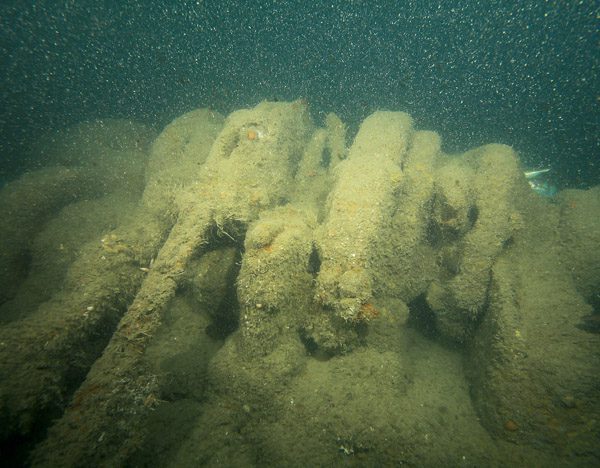
The seabed below the bow is again scoured down to 39m, though at this stage of the tour there is little point descending. With the tide off Beachy Head now picking up, ascent is best made by releasing a delayed SMB for a drifting decompression.
LAST SEEN OFF SELSEY BILL
THE 994-TON STEAMSHIP Newent was built as a collier in 1882 by Short Brothers of Sunderland, with a single boiler and two-cylinder compound engine by John Dickinson & Co, also of Sunderland. The cost to owner James Westoll was £26,000.
The shipping company carried mostly coal on the East Coast and grain from the Baltic.
In 1895, ownership passed to James Westoll’s son, also James. On 12 February, 1909, the Newent left Southampton for Blyth in ballast and was last seen that night off the Owens Lightship off Selsey Bill by the steamship Walter Scott.
No subsequent sightings were reported, and after the Newent failed to arrive in Blyth she was posted as missing with her crew of 16. The weather had been good, so a simple foundering was unlikely.
Lloyds underwriters concluded that the Newent was sunk off Beachy Head in the early morning of 13 February in a collision with the Norwegian barque Inga, which reported a seriously damaged bow in a collision with an unknown steamship.
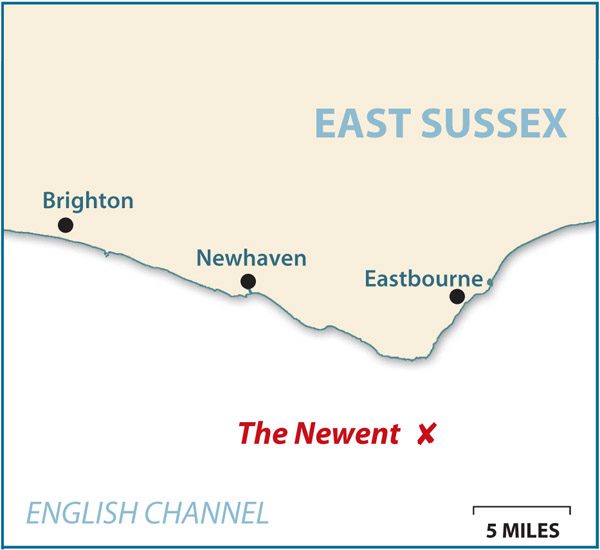
TOUR GUIDE
GETTING THERE: From the A27, take the A259 through Pevensey towards Eastbourne from the east. Sovereign Harbour is on the left. Turn left at the roundabout for Asda and the retail park, then continue straight across the mini-roundabout for the car park closest to the boarding pontoon.
HOW TO FIND IT: The GPS co-ordinates are 50 40.970N, 000 15.580E (degrees, minutes and decimals). The bow points to the east.
TIDES: Slack water is essential and is 5.5 hours before high water Dover, and again 30 minutes before high water Dover.
AIR: Our W has an onboard compressor and a limited supply of oxygen for mixing nitrox. If you require large quantities of oxygen, or any helium, it’s best to arrange it in advance. The nearest commercial air station is Newhaven Scuba Centre, 01273 612012,
DIVING Our W / Dive-125, 07764 585353.
ACCOMMODATION: Plenty of hotels and B&Bs serve the seaside and marina from Eastbourne to Pevensey. Camping is also available at Pevensey. For a diving budget, Dive 125 recommends the Cambridge Guest House, 01323 721100.
LAUNCHING: Slips at Sovereign Harbour (Eastbourne) and Newhaven. Qualifications BSAC Dive Leader or PADI Deep speciality combined with a decompression qualification from one of the technical agencies. Just within the range of a BSAC Sports Diver at low water.
FURTHER INFORMATION: Admiralty Chart 1652, Selsey Bill to Beachy Head. Admiralty Chart 536, Beachy Head to Dungeness. Ordnance Survey Map 199, Eastbourne & Hastings, Crowborough, Battle & Heathfield.
PROS: A less frequently dived wreck, because its identity was unknown until last year.
CONS: The wreck sits on a bank of silt, so visibility is often poor, hence the difficulty rating of 4.
DEPTH: 35m – 45m
Thanks to Dave Ronnan and Sylvia Pryer, Jamie Smith, Tunbridge Wells SAC.
Appeared in DIVER April 2013
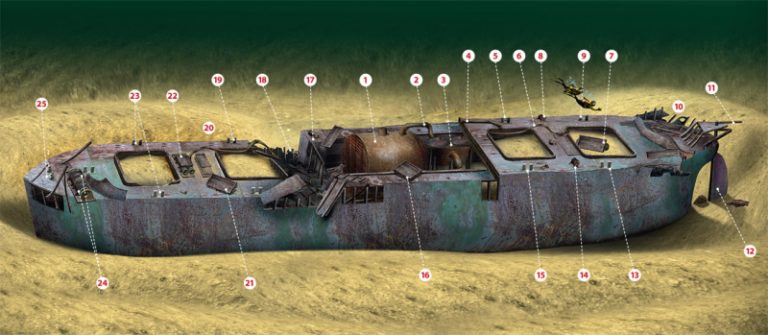

Very interesting to see what remains of the Newent. My great grandfather was one of the crew who were lost that day